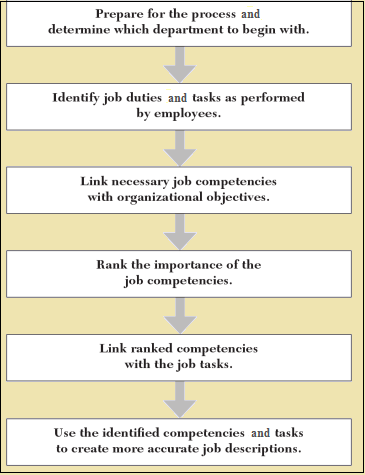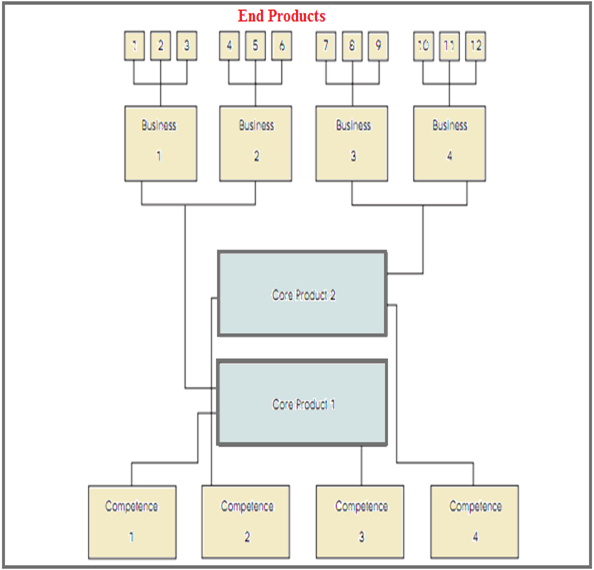Concept of Core Competence
Core competency is explained by academicians as an ability at which an individual is particularly proficient, or a set of actions that firms perform better than other functions whether more efficiently, at lower cost or at higher quality. The main attribute of core competencies is that it can transform into competitive advantages for small businesses and small business possessor. Knowledgeable entrepreneurs learn to recognize and control their core competencies to generate lean, high-performance organizations. Core Competence is array of skills integrated to make a company distinctive, the mechanism for new business development, and underlying component of a company's competitive advantage. It is shaped from the harmonization, integration of dissimilar skills and numerous technologies (Drejer, 2002).
The term core competency was invented by Dr.C.K Prahalad and Prof. Gray Hamel in 1989. Prahalad and Hamel stated that core competencies create core products which are not directly sold to customers instead they are used to develop huge number of client products. The notion of core competencies evolved from the resource-based view of the firm which emphasized the fact that competitive advantage rests on the firm's possession of unique difficult to imitate skills, knowledge, resources and competencies (Wernerfelt, 1984). Management studies have demonstrated that generally, core competencies have been seen as capabilities held by people within a firm that, when applied through corporate operational processes to create products and services, make a critical contribution to corporate competitiveness (Edgar and Lockwood; 2012).
Core competence is associated with resource allocation, capabilities, knowledge, skills, and expertise along with value chain. It needs three elements: skills, resources and processes (Torkkeli, Tuominen, 2002), and it is communication, involvement, and a deep commitment to working organizational boundaries (Franklin, 1997). Knowledge resources, innovative creativity and expertise are success factors that create the critical potential of an organization which is termed core competencies (Godbout, 2000). Therefore, a firm's core competence is described as a set of problem-defining and problem-solving insights that fosters the development of strategic growth alternatives (Lei et al., 1996).
The development of core competence is vital to organizational learning (Murray, 2003) and organizational culture (Haland and Tjora, 2006). Instead of a static stock of knowledge (Simpson, 2002), core competence develops from "collective learning in the organization"(Prahalad and Hamel, 1990) generating a set of problem-defining and problem-solving insights to create competitive advantage and acting as a vehicle for SBUs to find common interests, problems, capabilities or opportunities (Javidan, 1998).
A practical way to consider core competencies is to view these as aggregate of capabilities where synergy is created to deliver value. Within core competency aggregates, there are always at least two complementary critical capabilities. These critical capabilities are source of the power of competency and are where a company's strength can really distinguish it from other firms (Gallon et. Al, 1999). The major objective of core competencies is to gain sustainable competitive advantage. Studies have found that core competencies generate competitive advantage and affect organizational performance (Agha and Alrubaiee, 2012). A competitive advantage is significant if it is related to an attribute valued by the market. Customers need to perceive a consistent difference in important attributes between the producer's products or services and those of its competitors. These differences must relate to some product/delivery attributes which are among the key buying criteria for the market. Product/delivery attributes are those variables that impact the customers' perceptions of the product or service, its usefulness and its availability.
Chart: Process of core competency from initial assessment to new job description ( Source: Krompf, 2007)

Managing Core Competencies:
Main basis of core competencies are activities, skills and disciplines, which are termed primary capabilities (Gallon, Stillman, 1995). The aptitudes, the skills and motivation of the employees are essential conditions for develop a core competence because knowledge is carried through human resources to achieve the company's objectives (Godbout, 2000). In a sense, those core competencies must be a capability which the organization can sustain over time (Torkkeli, Tuominen, 2002). The management of technological competences is important because it produces increasing economic revenues as they focus more narrowly on knowledge assets and processes that are non-substitutable, rare, and valuable (Carayannis, Alexander, 2002). It is established that Core competence development efforts are based on capabilities, resources, organizational learning, R&D works, technology, and work teams. Additionally, the content and form of the core competencies are shaped through the linkages between the organization's goals, structure and culture (Godbout, 2000). Building competence needs huge amount and variety of employee participation, and demands demanding analytical activity (Gallon, Stillman, 1995), and organizational learning (Lei et al., 1996). Furthermore, core competencies should be developed around strategic business factors because this approach leads to a common understanding of where the key performance gaps were in the business (Clark, Scott, 2000).
Critical competence recognizes the unique competencies of a firm through generic techniques. In this sense, though the core competencies of firms are dissimilar, their critical competence is universal. Hamel (1994) has labelled the hierarchy and differences between meta-competencies, core competencies, and constituent skills.
Managing core competency of organization

Importance of core competences: Core competencies are significant for firms in competitive business climate. These are the combined learning of the organization, particularly how to co-ordinate the diverse production skill and amalgamate numerous technologies. Organizations which recognizes its core competencies can create more value and enhance output. Core competences must join together around individuals working in the organization. These people should identify their effort in building and underpinning these core competencies. Contrasting physical assets, which can depreciate with time, competences are enhanced as applied and share across the organization. The competences bind businesses simultaneously as well as cover the way for new business development. It is established that core competences of a business are also guiding principles for new markets and diversification (Drejer, 2002).
Organizational Core Competencies: In small scale companies, core competencies are related to a particular business function, such as marketing or manufacturing. Companies' core competencies can develop through the business owner's personal experience, the specific team the owner puts together or the company's responses to changing market conditions. It has been affirmed by scholars that one business can successfully manufacture products at high-quality standards, but the same organization may not be experienced in tax accounting. A different company may be run by a highly experienced tax accountant who knows nothing about manufacturing (Drejer, 2002). Core competencies must offer access to wide array of market, contribute significantly to the end product benefits and be difficult for competitors to imitate.
Competencies

Identification of core competencies: Core competencies has vital role in the process of leverage. It can be recognized through using three simple tests such as, Does the trait provide a major competitive differentiation? Does it provide a unique value proposition to the organization? Does the trait covers a lot of business or is useful only for a single business unit? Is it useful only for current business or for new ones too? Is it hard for competitors to imitate? Core competencies expand to the whole organization, and are part of strategic learning at the same time. A core competence is not a synonym of a core technology. A technology / technical capabilities is complete in itself while a core competence is entrenched inside the organization. Core capabilities are critical for continued existence but, dissimilar a core competency does not confer any specific differential advantage over other competitors in the business.

